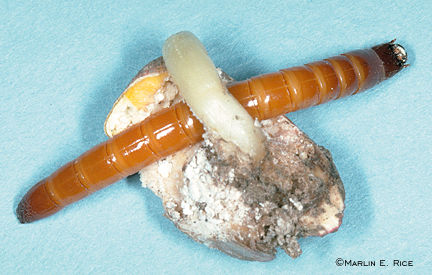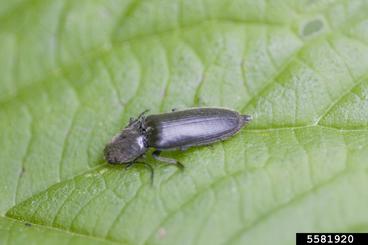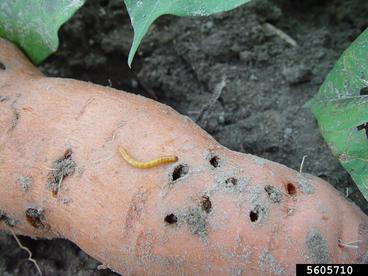E.C. Burkness and W.D. Hutchison
Department of Entomology, University of Minnesota
Introduction

Wireworms are common throughout the world and can be damaging pests of many different crops, most frequently sod, small grains, corn and beans. The wireworm feeds on seeds, preventing germination, or on the underground roots and stems of the plants, causing them to wilt or stunt their growth. Wireworms can also feed on edible roots and tubers (e.g., potato, sweet potato), causing a direct loss. The wireworm is the larval form of the adult click beetle; however, the click beetle adult is not considered a pest. Common species in the Midwestern U.S. include: corn wireworm (Melanotus cribulosus), sugarbeet wireworm (Limonius californicus) and wheat wireworm (Agriotes mancus).
Biology & Life Cycle

Wireworms are named after their long, wire like appearance. There are a wide variety of body characteristics among the different species. Some species are dark brown with hard bodies, while other species are soft with a white or yellowish coloration. Their body length is ½ to 1½ in. long. The wireworm can look similar to ground beetle larvae; however, ground beetle larvae have curved mandibles (mouthparts) in addition to two long structures extending from the end of the abdomen. These structures are absent on wireworm.
The click beetle, which is the adult stage of the wireworm, has a narrow body that is ½ in. long and is usually a brownish, grayish, or black color. In the event of getting turned upside down, they will flip the middle of the back against the ground propelling the body upward and making a "click" sound in the process. They will continue to perform this act until they have successfully turned themselves upright.
The lifecycle, beginning with the egg and ending with the adult, lasts between two and ten years. Eggs take anywhere from a few days to a few weeks to hatch. The majority of the lifecycle is spent underground in the larval stage, which takes two to six years to complete. As larvae get close to maturation, they will create a cell in the ground for pupation. With in a few weeks, they develop into mature adults and remain in the cell until the following spring. The adults will live ten to twelve months, mostly around the soil surface in crakes in the soil and will die shortly after laying eggs.
All life stages remain in the same locality of where they hatched (the adults will even return to where they hatched to lay their eggs) so one location could likely have multiple generations present. They prefer moist, cool, heavy soil. If the topsoil is too hot or too cold, they will migrate further down into the soil. They are therefore less likely to be detected in extreme conditions.
Damage

The click beetle does not inflict damage; it is the wireworm that feeds on crops and is a destructive pest. Wireworm has a wide host range including: corn, small grains, grasses, potato tubers, flowers, beans, peas, tomatoes, and cucurbits. The larvae primarily feed on small roots produced by the plants, or they will consume the insides of seeds, preventing germination. They will also burrow into larger roots and underground parts of the stem, cutting off the supply of nutrients and water to the plant. This results in the plants being stunted or wilted.
Wireworm infestations are generally not uniformly distributed throughout a field, so patches of damged areas often result.
Management
Cultural Control
Fields that were previously fallow or were planted with sod are more often infested with wireworms. Adults are more attracted to these areas and are more likely to lay their eggs in these sites. Since all generations tend to stay close to their origin, an infestation could continue for one to five years. In contrast, fields previously planted with corn or soybeans are at less of a risk of being infested. Crop rotation is an important tool to reduce wireworm numbers.
Generally, the longer it takes for a seed to germinate and grow, the more susceptible it is to wireworm damage. Therefore, it is better to plant the seeds when the soil is warm. Planting too early when it is cold and wet will slow growth and encourage damage. If it is necessary to plant early, the use of an insecticide when planting is helpful.
Commercial Growers
In order to determine a method of control, getting an estimate of the wireworm population is necessary. If birds are feeding in the field during cultivation, this could be an indicator that wireworms are present. To obtain a population estimate, a simple procedure using baits can be used. Begin one to four weeks prior to planting. First, soak an equal amount of untreated corn seed and wheat seed in water for 24 hours to encourage germination (wireworms are attracted to the carbon dioxide given off by the germinating seeds). Next, dig holes six inches deep and four inches wide; four traps per acre is the recommended intensity, but since this may be too time consuming, at least ten baits per field can be used for an accurate count. Once the holes are dug, fill them with one cup of the seed mixture. Then cover the hole up first with dirt and then with a black plastic bag. The bag will increase the temperature and encourage germination. Remember to flag the baits so they are easy to locate. After one week, return to the site and count the number of wireworms present in each trap.
If there is an average of one or more larvae per trap, then control will be necessary. Control is primarily limited to the use of insecticides. The insecticide can be applied prior to planting or by placing it in the furrow during planting. To ensure proper use of insecticides, refer to the most recent edition of the Midwest Vegetable Production Guide. There is no rescue treatment available once damage has occurred. If the larvae are seen but less than one is present per baited trap, then a seed treatment is recommended. However, this type of control only protects the seeds and not the seedlings. The absence of wireworms in the baits does not completely rule out the presence of an infestation.
Home Gardeners
The most effective method of control for a home garden is the use of baits. Baits can be planted two to four inches deep at three to ten ft. intervals. Fill the holes with a mixture of germinating peas, beans, or corn and cover with a board or tile. In one week, uncover the baits and kill the wireworms that have been collected. To collect and kill click beetles, pour syrup on an open surface, such as a fence post, near the garden area. Some species of the adults are attracted to the sweet syrup and will become stuck to it, allowing for easy disposal.
References
Ahlers, R. and E. Hodgson. 2005. Check for wireworm injury before planting. https://crops.extension.iastate.edu/cropnews/2015/05/check-wireworm-injury-when-assessing-corn-stands
Cornell University. 2003. Vegetable Disease ID and Management http://vegetablemdonline.ppath.cornell.edu/
Glogoza, P. 1998. Wireworm Management for North Dakota Field Crops. North Dakota State University, Fargo, North Dakota. https://agresearch.montana.edu/wtarc/producerinfo/entomology-insect-ecology/Wireworms/NDSUFactSheet.pdf (pdf)
Koch, R. 2015 Wireworm on soybean. University of Minnesota Extension. https://extension.umn.edu/pest-management/wireworm-soybean
Metcalf, R.L. & R.A. Metcalf. 1993. Destructive and Useful Insects. 5th Edition. McGraw-Hill, Inc. New York.
Potter, B. 2018. Wireworms and corn. University of Minnesota Extension. https://extension.umn.edu/corn-pest-management/wireworms-and-corn
University of Minnesota Extension Service BU-7094-S. Midwest Vegetable Production Guide for Commercial Growers;https://ag.purdue.edu/btny/midwest-vegetable-guide/Pages/default.aspx